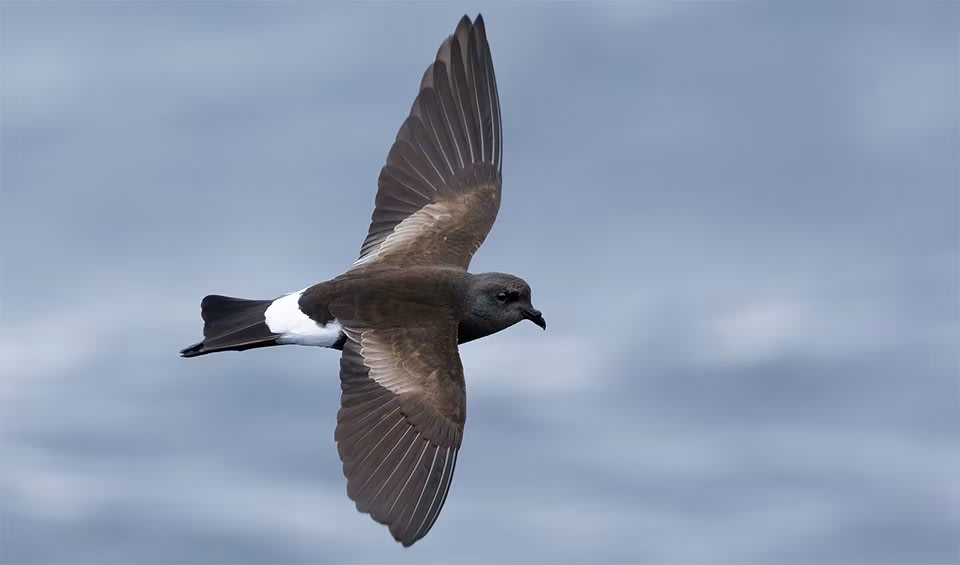Wilson’s storm petrel, named after the Scottish-American ornithologist Alexander Wilson, is indeed a fascinating and enigmatic seabird that holds the distinction of being Antarctica’s smallest warm-blooded bird to breed. Despite their diminutive size, these birds are highly adapted to life in the harsh and unforgiving environment of the Southern Ocean.
Wilson’s storm petrels are often seen in large flocks, gracefully skimming the ocean’s surface with their shallow wing beats. Their long legs and webbed feet allow them to hop across the water with remarkable agility, making them well-suited to their oceanic lifestyle. These seabirds are truly masters of the waves, effortlessly riding the swells and tides in search of food.
Speaking of food, Wilson’s storm petrels are opportunistic feeders, preying on a variety of small marine organisms such as fish, squid, and crustaceans. They are known for their quick dives into the water to catch their prey, using their keen eyesight and agility to target their quarry with precision.
During the breeding season, Wilson’s storm petrels seek out remote and inhospitable islands as nesting sites, where they construct hidden nests in rocky crevices or burrows. The choice of nesting sites serves as a form of protection from predators, allowing these birds to raise their young in relative safety.
Distribution
 American Samoa
American Samoa Angola
Angola Anguilla
Anguilla Antarctica
Antarctica Antigua & Barbuda
Antigua & Barbuda Argentina
Argentina Aruba
Aruba Australia
Australia Bahamas
Bahamas Bahrain
Bahrain Barbados
Barbados Benin
Benin Bermuda
Bermuda Bonaire Sint Eustatius And Saba
Bonaire Sint Eustatius And Saba Bouvet Island
Bouvet Island Brazil
Brazil British Indian T.
British Indian T. British Virgin Is.
British Virgin Is. Cameroon
Cameroon Canada
Canada Cape Verde
Cape Verde Cayman Islands
Cayman Islands Chile
Chile Christmas Island
Christmas Island Cocos Is. (Keeling)
Cocos Is. (Keeling) Colombia
Colombia Comoros
Comoros Congo-Brazzaville
Congo-Brazzaville Cook Islands
Cook Islands Costa Rica
Costa Rica Cuba
Cuba Côte D’ivoire
Côte D’ivoire DR Congo (Kinshasa)
DR Congo (Kinshasa) Denmark
Denmark Djibouti
Djibouti Dominica
Dominica Dominican Republic
Dominican Republic East Timor
East Timor Ecuador
Ecuador Egypt
Egypt Equatorial Guinea
Equatorial Guinea Eritrea
Eritrea Falkland Islands
Falkland Islands Fiji
Fiji France
France French Guiana
French Guiana French Polynesia
French Polynesia French Southern T.
French Southern T. Gabon
Gabon Gambia
Gambia Germany
Germany Ghana
Ghana Grenada
Grenada Guadeloupe
Guadeloupe Guatemala
Guatemala Guinea-Bissau
Guinea-Bissau Guinea
Guinea Guyana
Guyana Heard & McDonald
Heard & McDonald Iceland
Iceland India
India Indonesia
Indonesia Iran
Iran Ireland
Ireland Islands
Islands Israel
Israel Italy
Italy Jamaica
Jamaica Japan
Japan Jordan
Jordan Kenya
Kenya Kiribati
Kiribati Liberia
Liberia Madagascar
Madagascar Malaysia
Malaysia Maldives
Maldives Marshall Islands
Marshall Islands Martinique
Martinique Mauritania
Mauritania Mauritius
Mauritius Mayotte
Mayotte Mexico
Mexico Micronesia
Micronesia Morocco
Morocco Mozambique
Mozambique Myanmar
Myanmar Namibia
Namibia New Caledonia
New Caledonia New Zealand
New Zealand Nigeria
Nigeria Niue
Niue Norfolk Island
Norfolk Island Norway
Norway Oman
Oman Pakistan
Pakistan Panama
Panama Papua New Guinea
Papua New Guinea Peru
Peru Pitcairn
Pitcairn Poland
Poland Portugal
Portugal Puerto Rico
Puerto Rico Réunion
Réunion Saint Helena
Saint Helena Saint Martin
Saint Martin Saint Pierre
Saint Pierre Saint Vincent
Saint Vincent Samoa
Samoa Saudi Arabia
Saudi Arabia Senegal
Senegal Seychelles
Seychelles Sierra Leone
Sierra Leone Sint Maarten
Sint Maarten Solomon Islands
Solomon Islands Somalia
Somalia South Africa
South Africa South Georgia
South Georgia Spain
Spain Sri Lanka
Sri Lanka Suriname
Suriname Svalbard
Svalbard São Tomé & Príncipe
São Tomé & Príncipe Tanzania
Tanzania Togo
Togo Tokelau
Tokelau Tonga
Tonga Trinidad & Tobago
Trinidad & Tobago Turks & Caicos
Turks & Caicos Tuvalu
Tuvalu UAE
UAE US Minor Is.
US Minor Is. US Virgin Islands
US Virgin Islands United Kingdom
United Kingdom United States
United States Uruguay
Uruguay Vanuatu
Vanuatu Venezuela
Venezuela Wallis & Futuna
Wallis & Futuna Yemen
YemenAnything we've missed?
Help us improve this page by suggesting edits. Glory never dies!
Suggest an editGet to know me
Terrestrial / Aquatic
Altricial / Precocial
Polygamous / Monogamous
Dimorphic (size) / Monomorphic
Active: Diurnal / Nocturnal
Social behavior: Solitary / Pack / Herd
Diet: Carnivore / Herbivore / Omnivore / Piscivorous / Insectivore
Migratory: Yes / No
Domesticated: Yes / No
Dangerous: Yes / No




